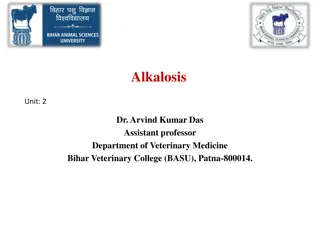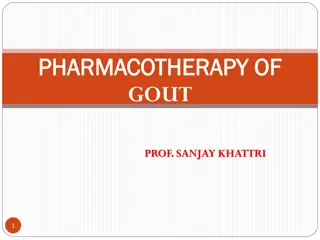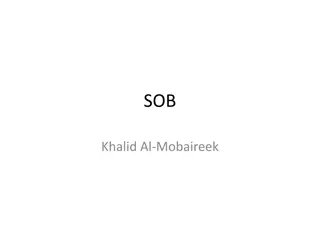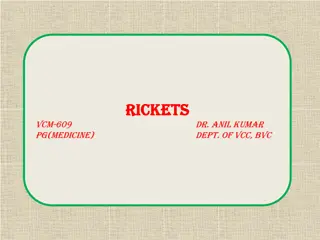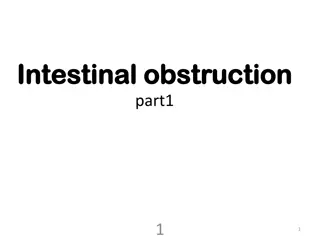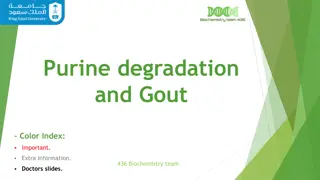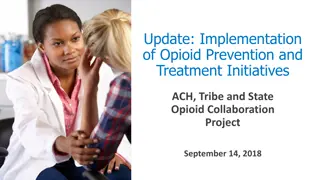Comprehensive Guide to Gout: Pathophysiology, Treatment, and Prevention
Gout is a form of arthritis characterized by painful joint inflammation due to urate crystal deposits. This guide covers the stages of gout, treatment options (both drug and non-drug), and the importance of managing the condition to prevent complications. Learn about the epidemiology, stages, and therapeutic objectives of gout, with an emphasis on drug classification and mechanisms of action.
Download Presentation

Please find below an Image/Link to download the presentation.
The content on the website is provided AS IS for your information and personal use only. It may not be sold, licensed, or shared on other websites without obtaining consent from the author.If you encounter any issues during the download, it is possible that the publisher has removed the file from their server.
You are allowed to download the files provided on this website for personal or commercial use, subject to the condition that they are used lawfully. All files are the property of their respective owners.
The content on the website is provided AS IS for your information and personal use only. It may not be sold, licensed, or shared on other websites without obtaining consent from the author.
E N D
Presentation Transcript
ilos Know the pathophysiology of gout Outline the stages of gout and the therapeutic objectives in each stage Describe drug and non-drug treatment of gout Classify drugs used for treatment of gout Identify the mechanism of action of drugs used for treatment of gout Study in detail the pharmacology of drugs used for treatment of gout
WHAT IS GOUT? Gout is usually characterized by recurrent attacks of acute inflammatory arthritis with red, tender, hot and swollen joints Deposits of sodium urate crystals in articular, periarticular, and subcutaneous tissues May be primary or secondary Primary hereditary error of purine metabolism Secondary drugs that inhibit uric acid excretion or increase rate of cell death or another acquired disorder
Untreated Gout May Lead to Tophaceous masses of MSU crystals in cartilage & joints, Renal stones, Urate nephropathy Joint inflammation Tofi Nephrolithiasis
epidemiology Gout was historically known as "the disease of kings" or "rich man's disease." Prevalence of hyperuricemia 5% Prevalence of gout 0.2% Male to female ratio 10:1
Stages of gout Four distinct stages: a)asymptomatic hyperuricemia; b)acute intermittent gout; c) Intercritical stage ; d) chronic gout -Prevent complications -Lower serum uric acid Treat or not to treat? Prevent recurrent attacks Terminate The attack
Drugs in gout https://pegsandtails.files.wordpress.com/2010/06/cruikshank__consolation_in_the_gout_c1796_01a.jpg https://pegsandtails.files.wordpress.com/2010/06/cruikshank__consolation_in_the_gout_c1796_01a.jpg Treatment of gout Non- Pharmacologic pharmacologic
Non Non- -pharmacologic Therapy pharmacologic Therapy http://www.buzzle.com/img/articleImages/427510-4125-18.jpg Lifestyle modifications Loss of weight Exercise Diet control Smoking cessation
Aim of pharmacotherapy Most therapeutic strategies for gout involve lowering the uric acid level below the saturation point (<6 mg/dL), thus preventing the deposition of urate crystals. This can be accomplished by: 1.interfering with uric acid synthesis with allopurinol, Febuxostat 2.increasing uric acid excretion with probenecid or sulfinpyrazone 3.inhibiting leukocyte entry into the affected joint with colchicine 4.administration of NSAIDs
Drugs in gout Uricostatic Allopurinol , Febuxostat http://rheuminfo.com/wp-content/uploads/2012/01/Gout-Sink-2.png Probenecid , Sulfinpyrazone Uricosuric Anti- inflammatory NSAIDs, Steroids Tubulin inhibitors Colchicine
Treatment of acute gout http://i1.mirror.co.uk/incoming/article3152264.ece/ALTERNATES/s1200/Gout.jpg http://i1.mirror.co.uk/incoming/article3152264.ece/ALTERNATES/s1200/Gout.jpg Acute gouty arthritis NSAIDs Colchicine Corticosteroids
NSAIDS NSAIDs are the most commonly used first-line treatment Head-to-head studies show few differences between drugs http://www.hydingout.org/wp-content/uploads/2014/02/gout-pain-foot-300x224.jpg Full doses of NSAID should be initiated immediately and tapered after resolution of symptoms Avoid NSAIDs: GI ulcer Bleeding or perforation Renal insufficiency Heart failure Use of oral anticoagulants
steroids Corticosteroids are a good alternative where NSAIDs and colchicine cannot be used or in refractory cases Studies showed equal efficacy between corticosteroid and NSAIDs, with no reported side-effects with short-term use of corticosteroids In elderly people, patients with liver or hepatic impairment, IHD, PUD, hypersensitivity to NSAIDs -Intra articularly (preferred route if one or two joints affected) -Orally -Intramuscularly or intravenously.
Colchicine https://robinkirbygattodotcom.files.wordpress.com/2014/01/1549575_720013181342553_62803538_n.jpg Alkaloid obtained from autumn crocus Minimal effect on uric acid synthesis , excretion & is not analgesic
mechanism Binds to microtubules in neutrophils Inhibits cell division Inhibits chemotactic factors Inhibits inflamosomes & IL-1 production
Colchicine pharmacokinetics Administered orally, rapidly absorbed from the GI tract Reaches peak plasma levels within 2 hours Recycled in the bile and is excreted unchanged in the faeces or urine Use should be avoided in patients with a creatinine clearance of less than 50 mL/min.
Colchicine Clinical uses - Treatment of gout flares - Prophylaxis of gout flares - Treatment of Mediterranean fever
adrs -Diarrhea (sometimes severe) -Nausea -Vomiting -Abdominal cramps -Dehydration Bone marrow depression -Cardiac toxicity, arrhythmia -Vascular collapse - Hepatotoxicity , alopecia
Prevention of recurrent attack Inhibition of uric acid synthesis -Allopurinol Uricosuric drugs Mammalian Uricase -Probenacid -Febuxostat -Sulfinpyrazone
Inhibitors of uric acid synthesis Inhibitors of uric acid synthesis Inhibit xanthine oxidase Include allopurinol & febuxostat Allopurinol is metabolized by xanthine oxidase into alloxanthine which is pharmacologically active
pharmacokinetics Absorption 70% Absorption 70% Protein binding Protein binding negligble negligble 5% 5% Hepatic metabolism, 70% converted to active metabolite( Hepatic metabolism, 70% converted to active metabolite(oxypurinol oxypurinol) ) Oxypurinol Oxypurinol is is elminated elminated unchanged in urine unchanged in urine Allopurinol Hypersensitivity Syndrome Xanthine Oxidase Toxic Epidermal Necrolysis Oxypurinol Allopurinol Dress Syndrome
adrs Diarrhea, nausea, abnormal liver tests Acute attacks of gout Fever, rash, toxic epidermal necrolysis hepatotoxicity, marrow suppression vasculitis DRESS syndrome Drug Reaction, Eosinophilia, Systemic Symptoms 20% mortality rate
Allopurinol Clinical uses Management of hyperuricemia of gout Uric acid stones or nephropathy It is a drug of choice in patients with both gout & ischemic heart disease Severe tophaceous deposits (uric acid deposits in tissues) Management of hyperuricemia associated with chemotherapy Prevention of recurrent calcium oxalate kidney stones
Drug Interactions Warfarin & dicumarol inhibits their metabolism Reduce the metabolism of 6-mercaptopurine and azathioprine With ampicillin : increases frequency of skin rash
Febuxostat Oral specific xanthine oxidase inhibitor Indicated for the management of hyperuricemia in patients with gout (as it reduces serum uric acid levels) Chemically distinct from allopurinol (non purine) Can be used in patients with renal disease
Febuxostat pharmacokinetics Given orally once daily, well absorbed (85%) Metabolized in liver , mainly conjugated to glucouronic acid Given to patients who do not tolerate allopurinol 99% protein bound 99% protein bound t 8 hours t 8 hours
Febuxostat adrs Increases number of gout attacks during the first few months of treatment Increases level of liver enzymes Nausea, diarrhea Headache Numbness of arm or leg
Uricosuric Uricosuric drugs drugs Mechanism http://tmedweb.tulane.edu/pharmwiki/lib/exe/fetch.php/probenecid.png?w=600tok=7307a8 Blocks tubular reabsorption of uric acid & enhances urine uric acid excretion Probenecid inhibits Urate Transporters (URAT) in the apical membrane of the proximal tubule It also inhibits organic acid transporter(OAT) plasma concentration of penicilin Sulfinpyrazol inhibits URAT1 & OAT4
Uricosuric Uricosuric drugs drugs Control hyperuricemia and Prevent tophus formation Probenecid moderately effective Increases risk of nephrolithiasis Not used in patients with renal disease Some drugs reduce efficacy (e.g., aspirin)
adrs Probenecid Exacerbation of acute attack Risk of uric acid stone GIT upset Allergic rash
Contra-indications History of nephrolithiasis Recent acute gout Existing renal disease Less effective in elderly patients
Drugs in Gout Sulfinpyrazone Sulfinpyrazone can aggravate peptic ulcer disease Aspirin reduces efficacy of sulfinpyrazone Sulfinpyrazone enhance the action of certain anti-diabetic drugs
Recombinant mammalian uricase Pegloticase A uric acid specific enzyme which is a recombinant modified mammalian uricase enzyme enzymatically convert urate to allantoin, which is more soluble and readily excreted in the urine Given I.V. peak decline in uric acid level within 24-72 hours
Pegloticase Used for the treatment of chronic gout in adult patients refractory to conventional therapy ADRS Infusion reactions Anaphylaxis Gout flare Arthralgia, muscle spasm Nephrolithiasis






